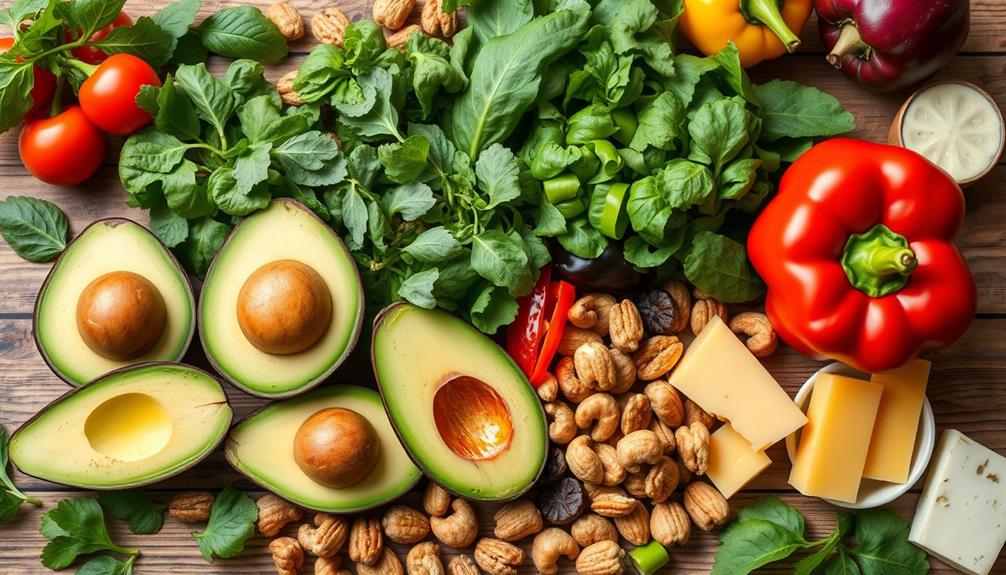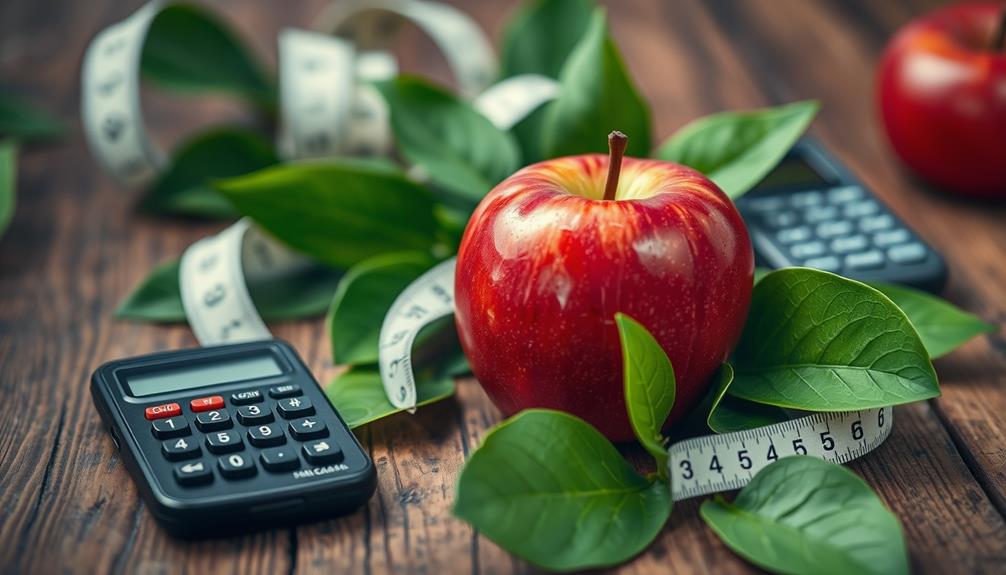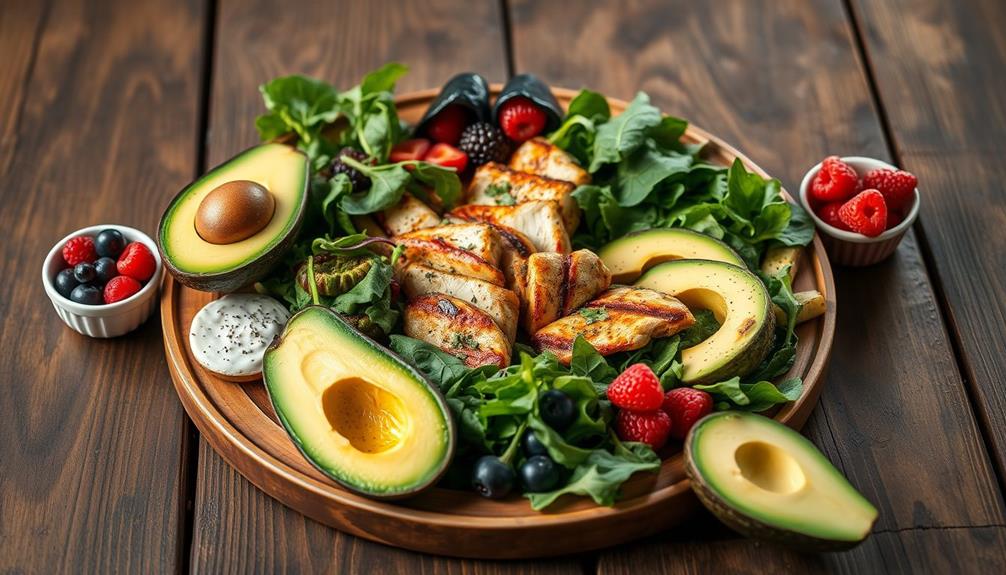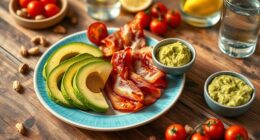To start the keto diet, focus on limiting carbs to below 50 grams daily and increasing healthy fats to about 70-80% of your caloric intake. Include foods like avocados, nuts, and fatty fish, while avoiding sugary snacks, grains, and high-carb fruits. Prepare meals ahead of time to stick to your goals and maintain variety with low-carb veggies. Stay hydrated by drinking 2-3 liters of water daily, and watch for potential side effects like the "keto flu." If you want to find out how to plan meals effectively and track your progress, there's plenty more to explore. Keto diet benefits include improved weight loss, increased energy levels, and better mental clarity. By following the guidelines and tips for starting the keto diet, you can experience these benefits and more. Be sure to consult with a healthcare professional before making any significant changes to your diet to ensure it’s the right choice for you.
Key Takeaways
- Understand the macronutrient ratio for the keto diet: 70-80% fat, 15-20% protein, and 5-10% carbohydrates.
- Focus on incorporating healthy fats like avocados, nuts, and olive oil into your meals.
- Eliminate sugary foods, grains, high-carb fruits, and starchy vegetables to maintain ketosis.
- Prepare meals in advance and track your food intake to adhere to ketogenic goals effectively.
- Stay hydrated by drinking 2-3 liters of water daily and boost electrolyte levels to avoid side effects.
Understanding the Keto Diet
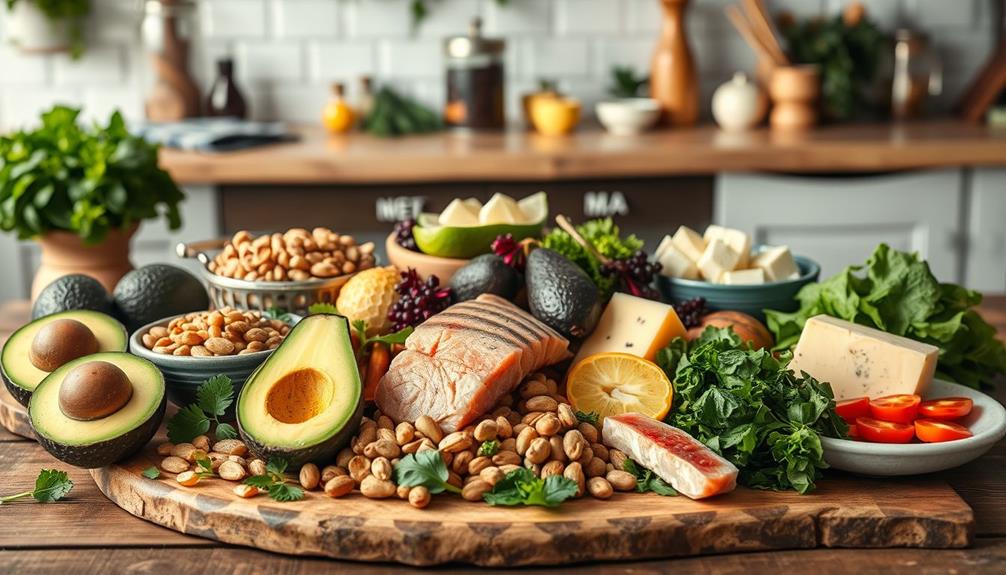
When you immerse yourself in the keto diet, you'll discover a high-fat, low-carbohydrate approach that can transform how your body uses energy. This diet is designed to induce a metabolic state called ketosis, where your body shifts from burning carbohydrates to burning fat for fuel. Typically, you'll need to reduce your carbohydrate intake to less than 50 grams per day to achieve this state. Incorporating effective strategies for weight loss can further enhance your experience on the keto diet.
The standard macronutrient ratio for the keto diet is about 70% fat, 20% protein, and just 10% carbohydrates. This means you'll focus on foods like fatty fish, avocados, and non-starchy vegetables while steering clear of grains and sugars.
Once you considerably lower your carb intake, you can expect to enter ketosis within 2-4 days, allowing your liver to produce ketones that serve as an alternative energy source for your brain.
While the keto diet offers health benefits, such as considerable weight loss and improved insulin sensitivity, be prepared for some common side effects during the initial phase. Often referred to as "keto flu," symptoms like fatigue and headaches will typically resolve within a few weeks as your body adapts to this low carb diet.
Key Foods to Include

To thrive on the keto diet, it's essential to focus on key foods that align with your macronutrient goals. You'll want to prioritize high-fat foods, as they should comprise about 70-80% of your daily caloric intake. Healthy fats like avocados, nuts, seeds, and oils (such as olive and coconut oil) are fundamental. Also, fatty fish is a great choice.
In addition, include non-starchy vegetables like leafy greens, broccoli, cauliflower, and zucchini to meet your low-carb requirement while still providing important nutrients. For protein, opt for quality sources like grass-fed meats, eggs, and unprocessed cheeses, aiming for around 15-20% of your daily calories.
Here's a quick reference table to help you:
| Food Category | Examples |
|---|---|
| Healthy Fats | Avocados, nuts, olive oil |
| Non-Starchy Veggies | Spinach, broccoli, zucchini |
| Quality Proteins | Grass-fed beef, eggs, cheese |
Foods to Eliminate
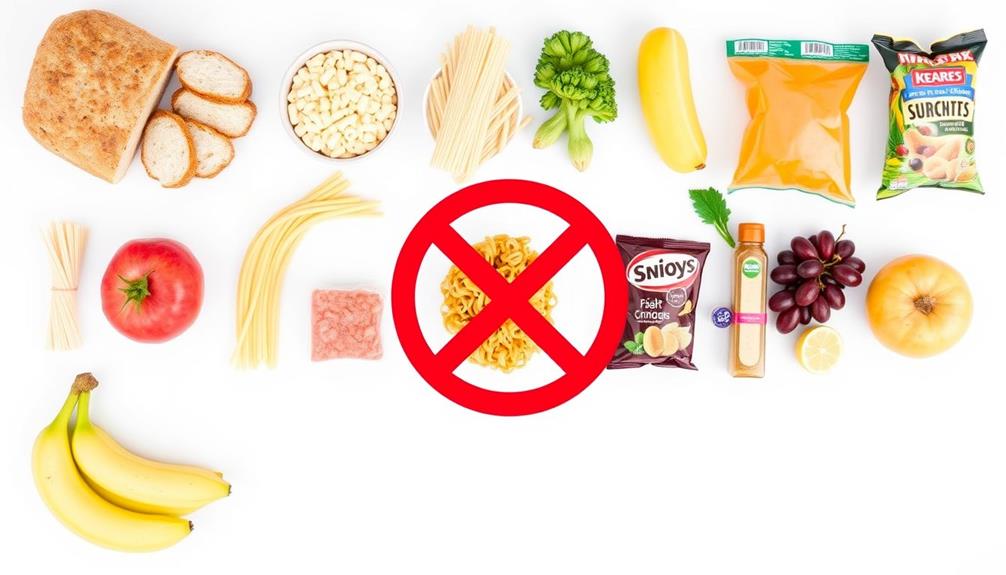
Successfully following the keto diet means not only knowing which foods to embrace but also understanding what to avoid. To maintain ketosis, you need to eliminate sugary foods entirely. This includes all forms of sugar, such as soda, fruit juices, cakes, candy, and ice cream, as they can quickly push you over your daily carb limit.
It's crucial to recognize that while cranberry juice is rich in antioxidants, it can also contain sugars that disrupt ketosis, so moderation is key potential side effects include gastrointestinal issues.
Next, steer clear of grains and starches. Foods like bread, pasta, rice, and cereals are high in carbohydrates and can disrupt your ketogenic state.
Similarly, when it comes to fruits, you should limit your intake to low-carb options like berries. Most fruits, such as bananas, apples, and grapes, contain too many carbs and should be avoided.
Additionally, exclude legumes and beans from your diet, as they're also high in carbohydrates.
Root vegetables like potatoes, carrots, and parsnips are starchy and can contribute excess carbs, making it harder to stay in ketosis.
Macronutrient Breakdown
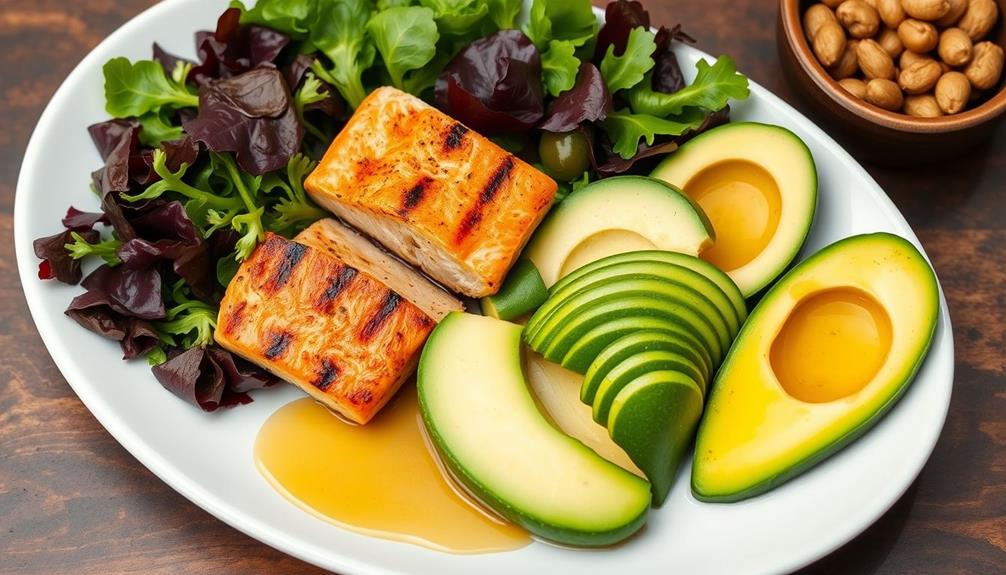
To succeed on a ketogenic diet, you need to focus on the right macronutrient ratios. Aim for about 70-80% of your calories from healthy fats, 15-20% from protein, and keep carbs to a minimum.
Incorporating foods beneficial for managing gout symptoms can also help if you're concerned about uric acid levels while following this diet.
Understanding where to source these fats and how much protein to consume will help you maintain ketosis effectively.
Ideal Macronutrient Ratios
Finding the right macronutrient ratios is essential for achieving the desired results on a ketogenic diet. The Standard Ketogenic Diet (SKD) typically consists of about 70% fat, 25% protein, and only 5% carbohydrates. This means you'll need to prioritize high-fat foods while keeping your carb intake to around 20-50 grams per day, which is roughly 5-10% of your total calories.
It's also important to keep in mind your overall financial health, as proper budgeting can help you afford the right foods for your diet. Consider creating a budget plan that accounts for both your dietary needs and other expenses.
If you're looking to maintain muscle mass, consider the High-Protein Ketogenic Diet (HPKD), which leans toward 60% fat, 35% protein, and 5% carbs.
For those who engage in high-intensity workouts, the Targeted Ketogenic Diet (TKD) allows for additional carbs around exercise, making up about 10-15% of your caloric intake.
Sources of Healthy Fats
Incorporating healthy fats into your ketogenic diet is essential for achieving your macronutrient goals. Healthy fats should make up 70-80% of your total caloric intake, so choosing quality sources is key to ensuring nutritional adequacy.
Different brewing methods, like French press coffee, can complement your keto meals by providing a rich, flavorful beverage without adding carbs.
Start with avocados, which provide around 15 grams of fat per medium fruit, mainly in the form of monounsaturated fats. Fatty fish, like salmon and mackerel, are also great options, giving you 13-20 grams of omega-3 fatty acids in a 3.5-ounce serving.
Don't overlook nuts and seeds either; for instance, a 1-ounce serving of almonds contains about 14 grams of fat, while chia seeds offer around 9 grams.
Oils like olive oil and coconut oil are staples in your keto diet. Just one tablespoon of olive oil contributes approximately 14 grams of fat, while coconut oil is rich in medium-chain triglycerides (MCTs) that your body can quickly convert into ketones, serving as a great source of fuel.
Protein Consumption Guidelines
Moderate protein consumption is essential for maintaining ketosis while supporting muscle preservation on a ketogenic diet. You should aim for protein intake to be around 15-20% of your total caloric intake. This helps avoid gluconeogenesis, where excess protein converts to glucose, disrupting your ketosis.
Incorporating techniques for effective editing can also help you refine your dietary approach and guarantee a well-rounded intake.
To optimize your protein consumption, consider the following guidelines:
- Aim for 0.55-0.77 grams of protein per pound of lean body mass.
- Focus on high-quality protein sources like grass-fed meats, fatty fish, eggs, and full-fat dairy.
- Monitor your total caloric intake to guarantee balance.
- Be mindful of your carbohydrate limits to stay in ketosis.
- Adjust your protein intake based on your activity levels and personal goals.
Meal Planning Strategies
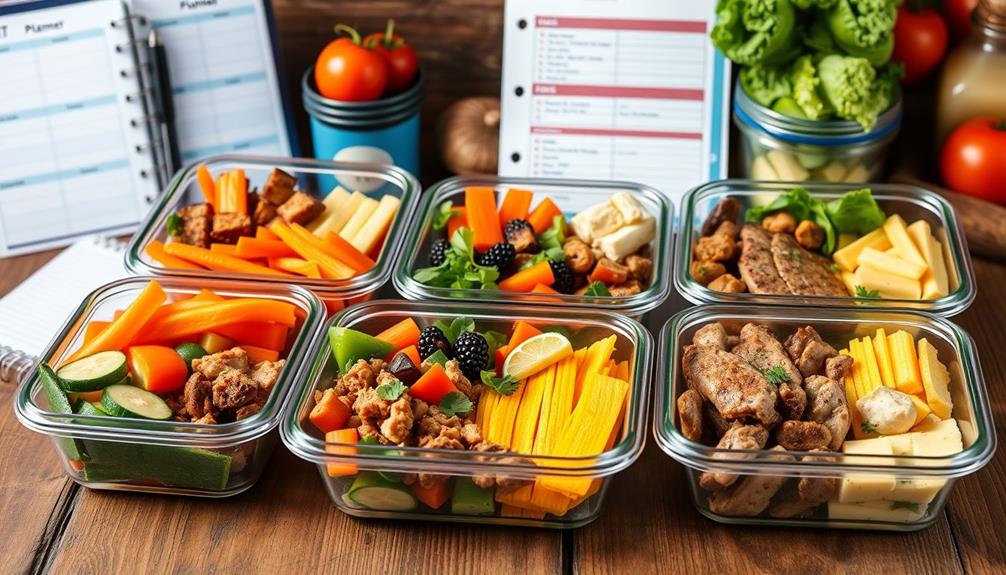
Effective meal planning is essential for succeeding on a keto diet, and it all starts with focusing on high-fat foods. Your meal plan should center around avocados, nuts, seeds, and fatty fish.
Imagination mobilizes mental potential when crafting meal combinations that excite your taste buds and keep your meals enjoyable. Aim to keep your carbohydrate intake below 20-50 grams per day to maintain effective ketosis.
To simplify your journey, utilize meal prep. By preparing keto-friendly snacks and meals in advance, you'll avoid the temptation of high-carb processed foods.
Incorporate a variety of low-carb vegetables, like leafy greens and other non-starchy options, to guarantee you're meeting your nutrient needs while sticking to your ketogenic goals.
Familiarize yourself with food labels to spot hidden carbs, making informed choices that help you stay within your daily limits.
Don't forget to explore online meal planning tools and keto recipe websites. They can introduce you to new dishes and keep your meals exciting, preventing dietary fatigue.
Managing Side Effects

As you commence your keto journey, managing potential side effects can make a significant difference in your experience. Many people encounter the dreaded keto flu, which can include symptoms like fatigue, headache, and nausea.
To navigate this phase, focus on hydration and electrolyte intake. It's also helpful to incorporate practices like gentle stretching before bedtime to promote relaxation and improve overall well-being.
Here are some tips to help you manage side effects effectively:
- Gradually reduce your carbohydrate intake over several days to ease your body into ketosis.
- Boost your electrolyte levels, especially sodium, potassium, and magnesium, to alleviate discomfort.
- Incorporate high-fiber, low-carb vegetables to combat constipation and digestive issues.
- Ascertain you're consuming adequate amounts of healthy fats to curb hunger pangs and maintain energy levels.
- If side effects linger beyond the initial weeks, don't hesitate to consult a healthcare professional for guidance.
Importance of Hydration

Staying hydrated is essential when you're on a ketogenic diet. As your body adjusts to lower insulin levels, it excretes more water and electrolytes, which can lead to dehydration if you're not careful. To combat this, aim to drink at least 2-3 liters of water daily, and adjust based on your activity level and climate.
Proper hydration helps alleviate symptoms of the "keto flu," like fatigue and headaches, especially during the initial shift to ketosis. Additionally, maintaining a balanced intake of fluids can enhance your energy levels, similar to how optimal comfort in varying weather conditions improves quality of life in heat pump systems.
Electrolyte balance is also vital for your well-being. Increase your intake of sodium, potassium, and magnesium to prevent cramping and fatigue associated with dehydration. You can do this through foods like avocados, leafy greens, and nuts, or consider supplements if needed.
A simple way to monitor your hydration status is by checking the color of your urine. A light yellow color indicates adequate hydration, while darker shades signal that you need to drink more water.
Tracking Your Progress

Tracking your progress on the keto diet is crucial for staying on course. You should monitor your macronutrient intake, record physical changes, and consider using tracking apps to simplify the process.
Additionally, incorporating healthy snacks can provide energy and support your overall wellness, similar to how healthy dog snacks promote canine vigor.
This way, you can make informed adjustments to optimize your results and stay motivated.
Monitor Macronutrient Intake
Monitoring your macronutrient intake is essential for achieving success on a ketogenic diet. By understanding the recommended ratios—70-80% fat, 15-25% protein, and 5-10% carbohydrates—you can create meals that keep you in ketosis.
Use food tracking apps or journals to log your daily meals and guarantee you stay within the target carb limit of 20-50 grams.
Here are some tips to help you along the way:
- Track your meals to stay accountable.
- Test your ketone levels regularly to gauge your progress.
- Include high-fat, low-carb foods like avocados, nuts, and olive oil.
- Adjust portion sizes based on your macronutrient goals.
- Celebrate small victories to keep your motivation high!
Consistently reviewing your food choices and adjusting your intake can promote effective weight loss and enhance the health benefits associated with the ketogenic diet.
Embrace the journey, and remember, every decision you make brings you one step closer to your goals!
Record Physical Changes
As you focus on your macronutrient intake, it's equally important to record physical changes throughout your keto journey. Start by tracking your weight regularly, but don't stop there. Measure your body fat percentage and take body measurements of your waist, hips, and chest to assess fat loss and muscle retention effectively. This thorough approach will give you a clearer picture of your progress.
Keep a journal of your daily food intake and ketone levels. This can help you identify which foods keep you in ketosis and how they affect your weight. Regularly monitoring your energy levels, mood, and cognitive clarity is also essential. These indicators can reveal the diet's overall impact on your well-being and alert you if adjustments are needed.
Don't forget the power of progress photos! Taking these every few weeks can visually document your transformations and motivate you to stay committed.
Use Tracking Apps
To effectively manage your ketogenic diet, consider using tracking apps that simplify the process of monitoring your macronutrient intake. These tools can be game-changers, helping you maintain the recommended ratios of 70% fat, 20% protein, and 10% carbohydrates necessary for ketosis.
Here are some benefits of using tracking apps:
- Easy food entry: Many apps feature barcode scanning for quick tracking.
- Comprehensive databases: Access a vast library of foods and recipes for precise nutrient tracking.
- Identify patterns: Understand your eating habits and make informed adjustments to your diet.
- Stay accountable: Regular logging reinforces your commitment and motivation.
- Visual progress: Seeing your data can boost your determination to stick to your plan.
Popular options like MyFitnessPal and Cronometer offer user-friendly interfaces and robust features.
By utilizing these tracking apps, you can easily monitor your macronutrient intake and stay on track with your ketogenic diet. You'll not only make your journey more manageable but also enhance the effectiveness of your dietary choices.
Embrace technology—your success on the keto path could depend on it!
Long-term Considerations

Long-term considerations are essential when following the ketogenic diet, as its restrictive nature can lead to nutrient deficiencies over time.
While you might enjoy short-term weight loss and certain health benefits initially, sticking to keto for an extended period isn't generally recommended by experts. They often suggest cycling between keto and other dietary patterns to maintain sustainability and prevent adverse effects on your heart health.
It's important to focus on quality fat sources, as unhealthy fats can impact your cardiovascular system adversely.
Additionally, when moving back to a balanced diet after keto, be careful; many people revert to previous eating habits, leading to weight regain.
Regularly monitoring your health markers can help you stay on track and avoid potential deficiencies.
If you have pre-existing health conditions or are taking medication, consulting a healthcare provider is essential before starting or continuing a ketogenic diet. They can guide you through managing your health effectively while pursuing your weight loss goals.
Resources for Keto Success
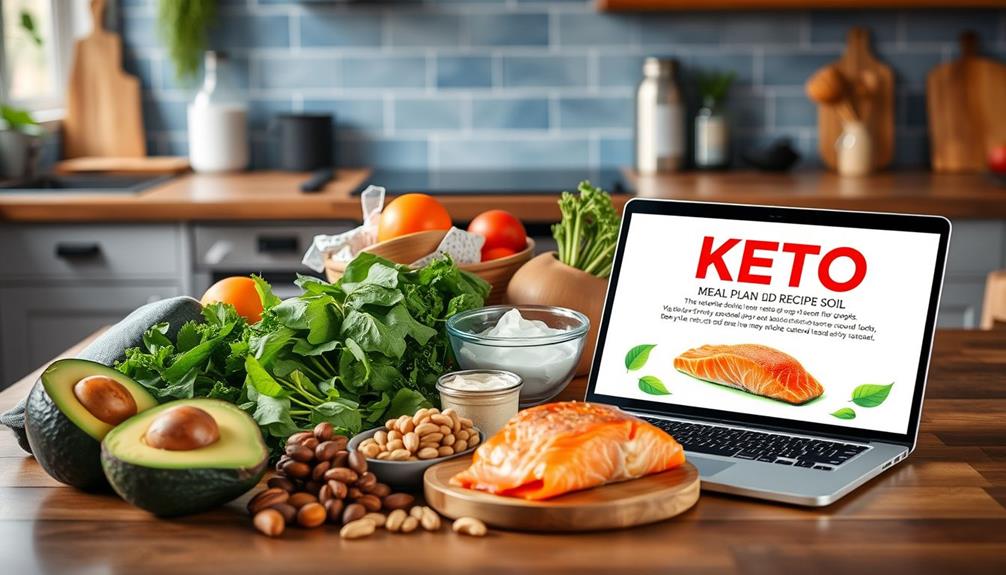
Sustaining success on the ketogenic diet can be enhanced by tapping into valuable resources. By leveraging the right tools, you'll not only stay on track but also enjoy the journey.
Here are some essential resources to contemplate:
- Keto-specific cookbooks: Discover a variety of delicious recipes that fit your macronutrient goals.
- Health tracking tools: Use apps to monitor your macronutrient intake, progress, and ketone levels, keeping you accountable.
- Online forums: Join support groups where others share experiences, tips, and motivation to maintain your keto lifestyle.
- Reputable sources: Utilize expert insights from trusted organizations like the Cleveland Clinic and Mayo Clinic for guidance.
- Consult healthcare providers: Work with professionals, especially if you have existing health conditions, for tailored advice that suits your needs.
Frequently Asked Questions
How Do I Start Going on Keto?
To start going on keto, you'll greatly reduce carbs, focus on high-fat foods, and moderate protein. Familiarize yourself with food labels, plan meals ahead, and monitor your ketone levels to guarantee you're in ketosis.
How Do I Get Myself Into Keto?
To get yourself into keto, start by cutting carbs drastically, upping healthy fats, and incorporating MCTs. Regular exercise and short fasting can speed up your shift, helping your body burn fat efficiently for energy.
How Can I Get Keto?
Did you know that nearly 60% of people find success on a ketogenic diet? To get keto, cut your carbs to 20-50 grams daily, focus on healthy fats, and monitor your macros closely.
What Are the 9 Rules of Keto?
When you're diving into keto, remember these nine rules: limit carbs, increase healthy fats, moderate protein, stay hydrated, maintain electrolytes, monitor ketone levels, choose whole foods, plan meals, and listen to your body's signals.
Conclusion
As you commence your keto journey, picture yourself savoring a rich, creamy avocado, the vibrant colors of fresh leafy greens on your plate, and the satisfying crunch of nuts. Embrace the energy boost that comes with each low-carb meal, and watch your progress unfold like a beautiful sunrise. With dedication and the right resources, you'll not only transform your body but also discover a delicious world of flavors. So, plunge in and enjoy every bite of this adventure!
